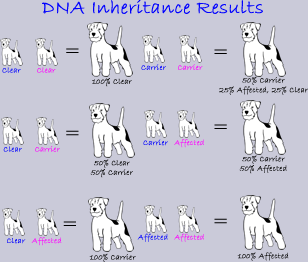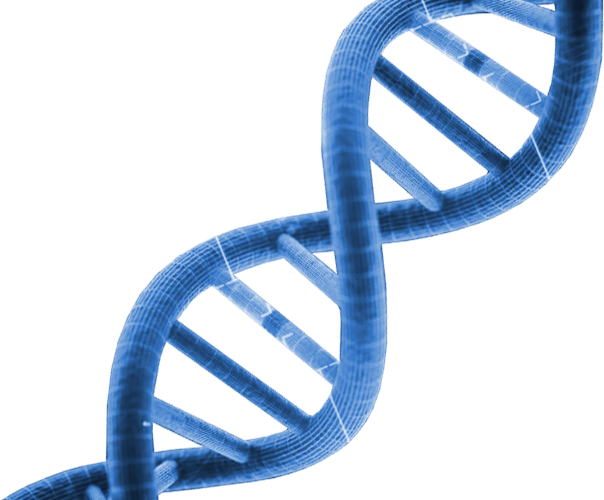Health of Jack Russell Terriers
Late Onset Ataxia (LTA)
Primary Lens Luxation (PLL)
Spinocerebellar Ataxia (SCA)
Degenerative Myelopathy DM (Exon2)
Degenerative myelopathy initially affects the back legs and causes muscle weakness and loss, and lack of coordination. These cause a staggering effect that may appear to be arthritis. The dog may drag one or both rear paws when it walks. This dragging can cause the nails of one foot to be worn down. The condition may lead to extensive paralysis of the back legs. As the disease progresses, the animal may display symptoms such as incontinence and has considerable difficulties with both balance and walking. If allowed to progress, the animal will show front limb involvement and extensive muscle atrophy. Eventually cranial nerve or respiratory muscle involvement necessitates euthanasia. Progression of the disease is generally slow but highly variable. The animal could be crippled within a few months, or may survive up to three years.
Juvenile Brain Disease (JBD) / Juvenile Encephalopathy (Epilepsy)
Juvenile Encephalopathy is a severe brain disorder, with an early onset of around 6-12 weeks. Affected dogs suffer from epileptic seizures, with the disease progressing rapidly causing irreversible brain damage.
DNA Results Explained
CLEAR: these dogs have no copies of the mutant gene responsible for the condition and will neither develop the condition nor pass the gene on to their offspring.
CARRIER: these dogs have one copy of the normal gene and one copy of the mutant gene; they will not develop the condition, but will pass a mutant gene on to approximately half of their offspring.
AFFECTED: these dogs have two copies of the mutant gene that causes the condition and will develop the disease.
Patella Luxation
Patella luxation in dogs is a condition where the patella or "knee-cap" can move from its normal central position at the front of the knee or "stifle joint" to one side or the other. This condition is more common in the smaller breeds, however it may occur in large breeds and also cats.
In most dog breeds the most frequent direction of abnormal movement or "subluxation" is towards the midline of the dog- "medial patellar luxation". In some cases the subluxation can be away from the midline of the dog and is called "lateral patellar luxation".
What are Patella Luxation testing & scoring schemes?
Patella Luxation testing & scoring schemes in dogs are organised by many responsible breed associations or societies in breeds which have an increased frequency of patellar luxation.
The dog breeder or owners bring their dogs which they plan to breed from for an examination by a veterinary surgeon who is familiar with the Putnam Patellar Luxation Grading System. The examination is normally performed during an orthopaedic examination without sedation. Radiographs are not required but may be arranged in requested. In the UK & Ireland there is no official Kennel Club testing scheme for Patella Luxation as there are for Hip & elbow dysplasia and eye screening. However some breed Clubs hold a database of those dogs which have been checked for patella luxation using the Putnam (1968) testing and scoring method.
What do the different scores mean in the Putnam Patellar luxation Grading system for dogs?
The Putnam grading system grades dogs from Grade 0 - no luxation present - normal, to increasing severity from Grade 1-4.
The following description is used by some breed societies as guidance although slight variations in the wording and description exists between breed societies. Most breed societies provide their own forms for the vet to complete.
Grade 0: Normal
Grade 1: the patella can be manually luxated with the stifle in full extension, but when pressure is released without manipulation of the limb the patella regains its original position in the trochlea. Spontaneous luxation of the patella during normal joint motion rarely occurs. Typically stifle and hock in a straight line with no deviation of the hock.
Grade 2: the patella can be completely luxated, but manipulation of the hind limb (flexion of the stifle) causes the patella to regain its original position in the trochlear. On physical examination, the patella luxates easily, especially when the foot is rotated.
Grade 3: the patella is found (at least once) spontaneously luxated with the animal in a standing position or it is permanently luxated but can be repositioned manually or by manipulating the limb. Very shallow or flattened trochlear.
Grade 4: the patella is permanently luxated and cannot be repositioned. May scarcely be able to walk or may move in a crouched position with both limbs partially flexed, and/or they may carry the affected limb. Trochlea is shallow, absent or even convex.
BVA/KC/ISDS Eye Screening Scheme
The BVA/KC/International Sheep Dog Society (ISDS) Eye Scheme offers breeders the opportunity of screening for inherited eye disease by examination of the eye. Examination under the eye scheme is not restricted to the identification of inherited eye disease, but also includes general assessment of the health of the eye and adnexa (eyelids, tear ducts and other parts around the eye ball).
How an eye condition is inherited varies dramatically. Some eye conditions may be controlled by a number of different genes, as well as environmental factors. Others may be entirely controlled by just one gene and some may not be inherited at all.
Breeders can screen their breeding stock for known and emerging inherited diseases before the dogs are bred from. Testing all potential breeding stock allows breeders to better understand the genes a dog may pass on to its puppies and reduce the risk of inherited diseases appearing in future generations.










